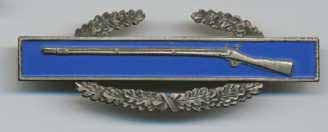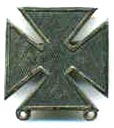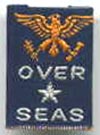
Combat Infantryman Badge
BUD HAUGH'S BADGES
WORLD WAR II
All pictures are scans of Bud's
actual Badges, except where noted.

Combat Infantryman Badge
Qualifying for the Combat Infantryman Badge separated ordinary
men, in any Infantry Regiment, from those
fully qualified for combat infantry duty. More emphasis was added by the additional ten
dollars per month pay,
that went along with the badge. A nice increase considering a Private's pay was fifty
dollars a month in 1944.
 U. S.
Army Marksman Badge
U. S.
Army Marksman Badge
The Marksman Badge was awarded when a soldier qualified, with a weapon, as a Marksman. To be fully represented, the two loops, at the bottom, would have the name of the weapon with which the soldier had qualified. Like many other awards , in World War II, the military never seemed to get around to issuing, the weapons portion is not present on Bud's metal.
Since he was a qualified Rifleman, the following should have
been attached to the bottom of his badge: ![]() (file
image)
(file
image)
 The Ruptured Duck Lapel Button
The Ruptured Duck Lapel Button
The Origin of "The Ruptured
Duck" Patch / Lapel Button

(file image)
The original Ruptured Duck was a cloth insignia, depicting an eagle inside a wreath, the
background was diamond shaped.
It was sewn on uniforms above the right breast pocket. Issued to World War II service
personnel, about to leave the military, with an Honorable Discharge. It also allowed them
to continue to wear their uniform for up to thirty days, after discharged, since there was
a clothing shortage at the time. This showed the Military Police they were in transit and
not AWOL(Absent Without Leave). The boys thought the eagle looked more like a duck;
and, because it meant they were going home, a popular saying at the time was, "They
took off like a Ruptured Duck."
It didn't take long for the nickname to 'stick.'
 OVERSEAS BADGE ~ WORLD WAR II
OVERSEAS BADGE ~ WORLD WAR II
Embroidered on Cloth, attached to metal backing,
containing a pin clasp.
Issued for overseas service during World War II.
Posted/Revised June 16, 2001